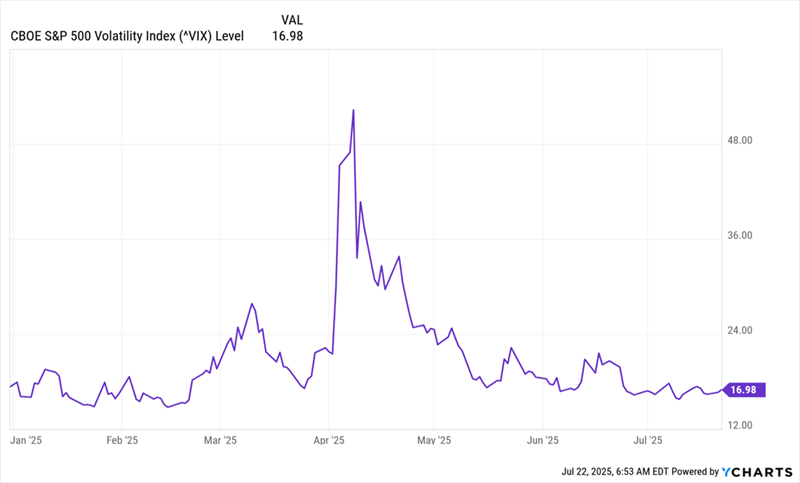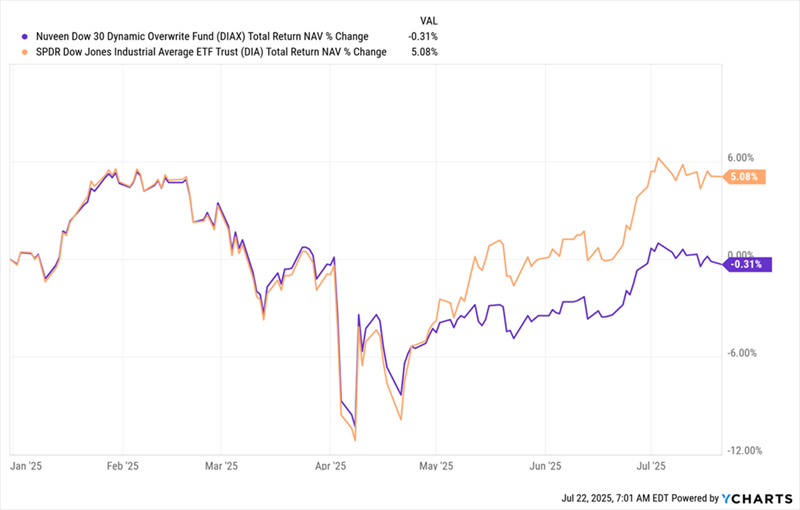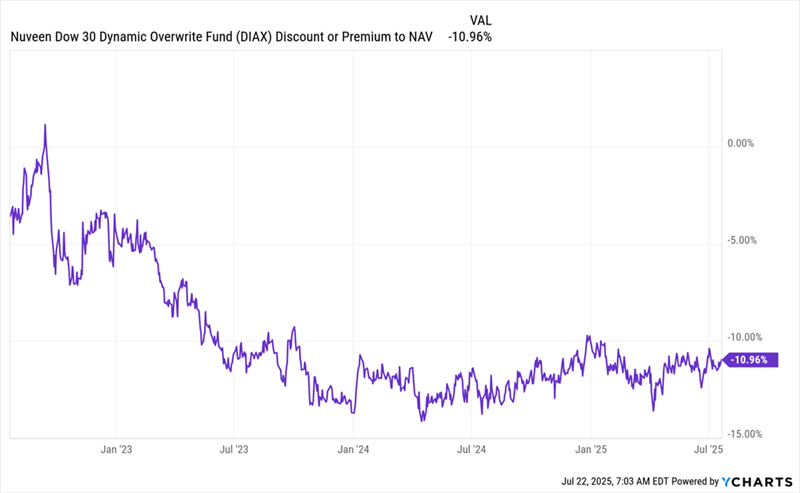Fire Powell? Keep him around? The question never seems to go away—and the markets, fueled by the so-called “TACO” trade (“Trump always chickens out,” as the acronym goes), are shrugging it all off.
But what if Trump calls Wall Street’s bluff? Luckily, there are not one but three ways for us to hedge ourselves from the “TACO trade” going cold. Below, we’ll look at all three and I’ll name my favorite of this trio. Plus we’ll grab ourselves tidy dividends of 7%+, too.
Powell Has Been On His Way Out (or Not!) for Months
If you’re experiencing déjà vu, it’s because this same story happened back in April, and it sent stocks plunging back then. This latest time, however, it’s had little impact at all.
But why would stocks sell off based on Powell’s firing in the first place? It’s because of the Federal Reserve’s independence. Its operation of the country’s banking and financial system without intervention from the executive branch has been a mainstay since the central bank’s creation a century ago. And Wall Street wants things to stay that way.
So, can we march forward into the future without worrying that Powell will be replaced and a new Fed chair will be inserted who bows to political pressure? This, after all, could increase the odds that will be cut too much—as low rates are popular—potentially goosing inflation in the process.
In the long term, yes—the chances of a “new normal,” where the Fed just does what the president says, are basically zero. But in the short term, a selloff driven by this risk is a distinct possibility.
That’s because, over the last few weeks, markets have become increasingly complacent, and stocks have gone from volatile to solidly positive.
As I write this, the is up 7.8% for 2025, which is about where it should be, in my view. And I expect it to end 2025 higher still. But the , the market’s “fear gauge,” soared in April, slowly fell back down, and is now a bit lower than where it started the year.
VIX Shows an (Overly?) Chill Market

In other words, the markets are now saying that stocks are less risky than they were at the start of 2025—even after all the talk about tariffs firing Powell, neither of which have fully gone away.
Why? Because now the markets are banking on the TACO trade: If Trump keeps “chickening out,” as the acronym goes, he can be easily ignored.
However, this is, paradoxically, a risk. Whatever your politics, it’s undeniable that Trump follows the equity markets and responds to them. Stocks recovered only after Trump backed off on the tariffs in April, which he did only after stocks fell. Stock market performance clearly matters a lot to Trump.
As a result, we’re in a weird situation where a continued stock rally could encourage Trump to reverse moves that caused the market to tumble in the past. That would likely cause another drop, which could then prompt Trump to reverse course.
As of now, stocks are simply jumping to the last step, rising on the assumption Trump will always back off. Which, ironically, gives him exactly the room he needs to do things that will cause stocks to fall, like firing Powell, for example.
It’s all a bit exhausting! But this is where those funds I mentioned earlier come in.
How We’re Hedging Against Volatility for an 8.4% Dividend (at 11% Off)
Right now, volatility itself is low, and that means any kind of “insurance” on the market hitting another storm is cheaper than normal. The “insurance” I want to tell you about today comes in the form of closed-end funds (CEFs) that buy or sell options on the stocks they hold.
Under this strategy, these funds charge a fee, called a “premium,” to option traders for the right to buy the stocks in their portfolios at a fixed date and price in the future. They then use the premiums they collect to fund their dividends, which, as we’ll see shortly, are well north of 7%.
This strategy works best in volatile markets—which means today’s lower volatility has put many of our favorite covered-call funds on sale.
The three “go-to” covered-call CEFs out there are the Nuveen Dow 30 Dynamic Overwrite Fund (NYSE:), which, as the name says, holds the stocks in the ; the S&P 500–focused Nuveen S&P 500 Dynamic Overwrite Fund (NYSE:); and the Nuveen NASDAQ 100 Dynamic Overwrite Fund (NASDAQ:).
Between them, they provide broad exposure to the biggest companies in America, like Visa (NYSE:), Amazon.com (NASDAQ:) and NVIDIA (NASDAQ:). In other words, many of the same names you’d get if you bought an index fund. But with this trio, we’re getting much higher yields than any index fund pays.
And second, unlike ETFs, CEFs (including these three) can trade at a “discount to NAV,” or net asset value. That’s another way of saying we can buy shares of their portfolios for less than they’re actually worth.
QQQX tends to be my favorite of these because it often yields the most and has the highest discount. But right now, it yields essentially the same as DIAX, while DIAX offers a much wider discount. That makes DIAX the best buy of the lot today. SPXX, with its 7.5% yield, isn’t generous enough with its dividend, and its discount of 1.3% is almost nonexistent.
So if you want to stay in stocks (or stock-focused funds—which we do!) and hedge for future volatility, DIAX is the way to go. Consider also this chart.
DIAX’s Growing Divergence

On a NAV basis (or going by the performance of its underlying portfolio), DIAX (in purple above) was pretty closely matching its underlying Dow Jones Industrial Average index (in orange) until late April, when a sudden drop in volatility caused DIAX’s portfolio to underperform, and its underperformance has widened since.
That’s an opportunity for a contrarian pickup, especially given the fund’s unusually large discount.
DIAX Is Weirdly Cheap

Back in 2022, when volatility was peaking, DIAX saw a flurry of demand. But as stocks have recovered, more money has flowed to alternatives, setting this fund’s discount roughly between 11% and 13%, where it’s been for over a year now. That’s unusual for DIAX, whose average discount has been 6.7% over the last decade.
That makes DIAX a timely contrarian play on a rise in volatility, since its covered-call strategy makes it rise as markets get more skittish—and investors look for more “insurance” from the next big plunge.
Disclosure: Brett Owens and Michael Foster are contrarian income investors who look for undervalued stocks/funds across the U.S. markets. Click here to learn how to profit from their strategies in the latest report, “7 Great Dividend Growth Stocks for a Secure Retirement.”